Abstract
Karyological examinations performed 24 hr to 11 days after Sendai virus-induced fusion of mouse cells of the permanent line 3T3 and human diploid cells, suggest that hybrids with extensive loss of human chromosomes derive from fusion involving all the chromosomes of both parental cells. Examination of 39 independent clones isolated from two different crosses between L mouse cells and cells of two permanent human lines, D98/AH2 and VA2, show that the karyotypes of human-mouse hybrids are a function of the interaction between the parental cells: the mouse chromosomal complement may be doubled or not. For the first time, viable hybrids that have retained almost all of the human chromosomes have been isolated.
Full text
PDF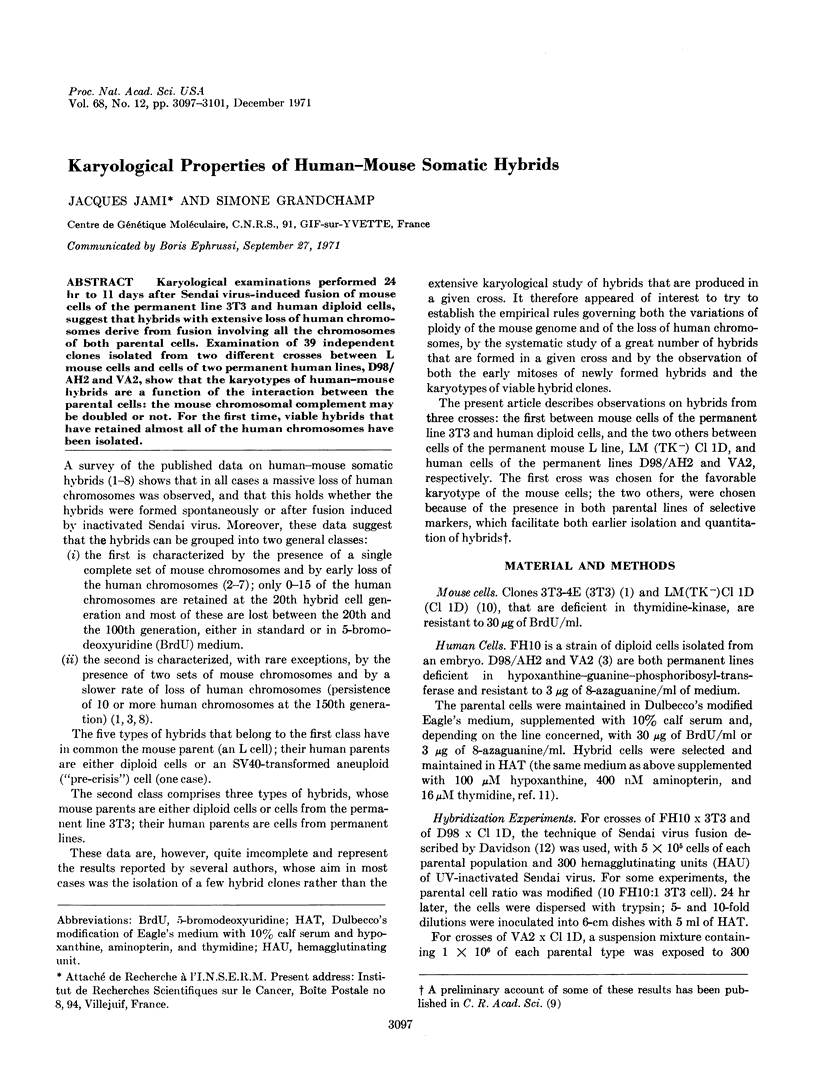
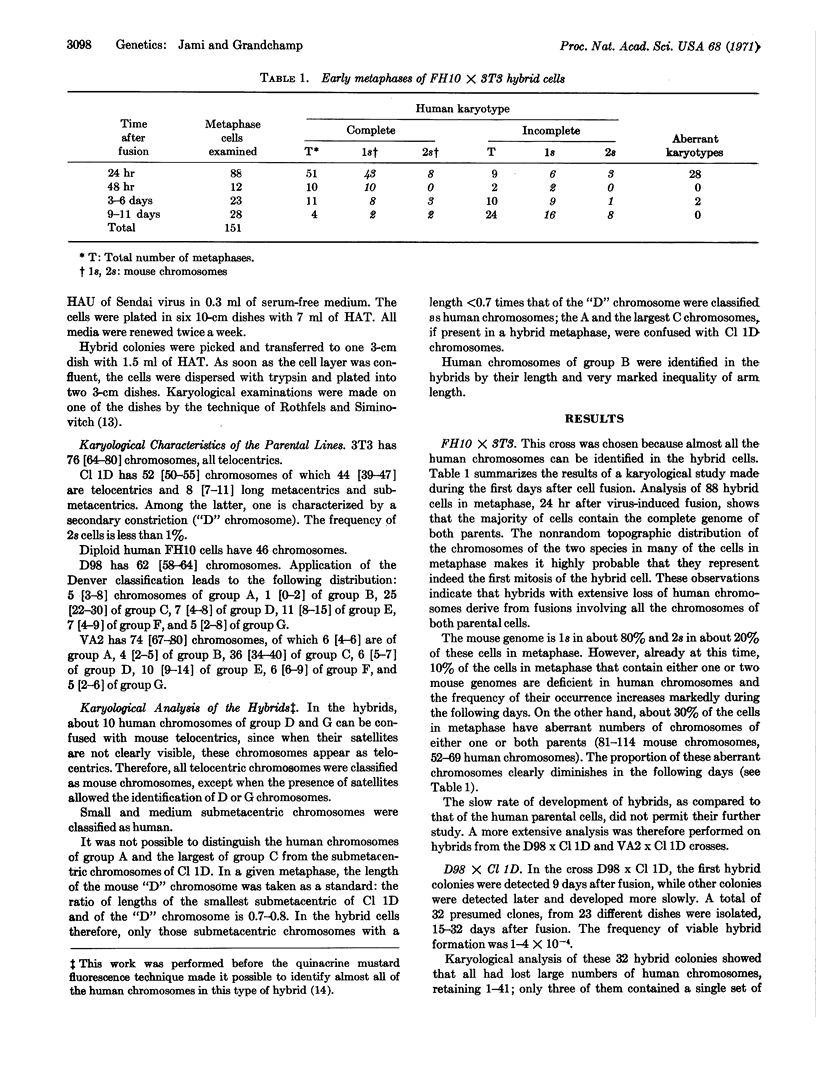
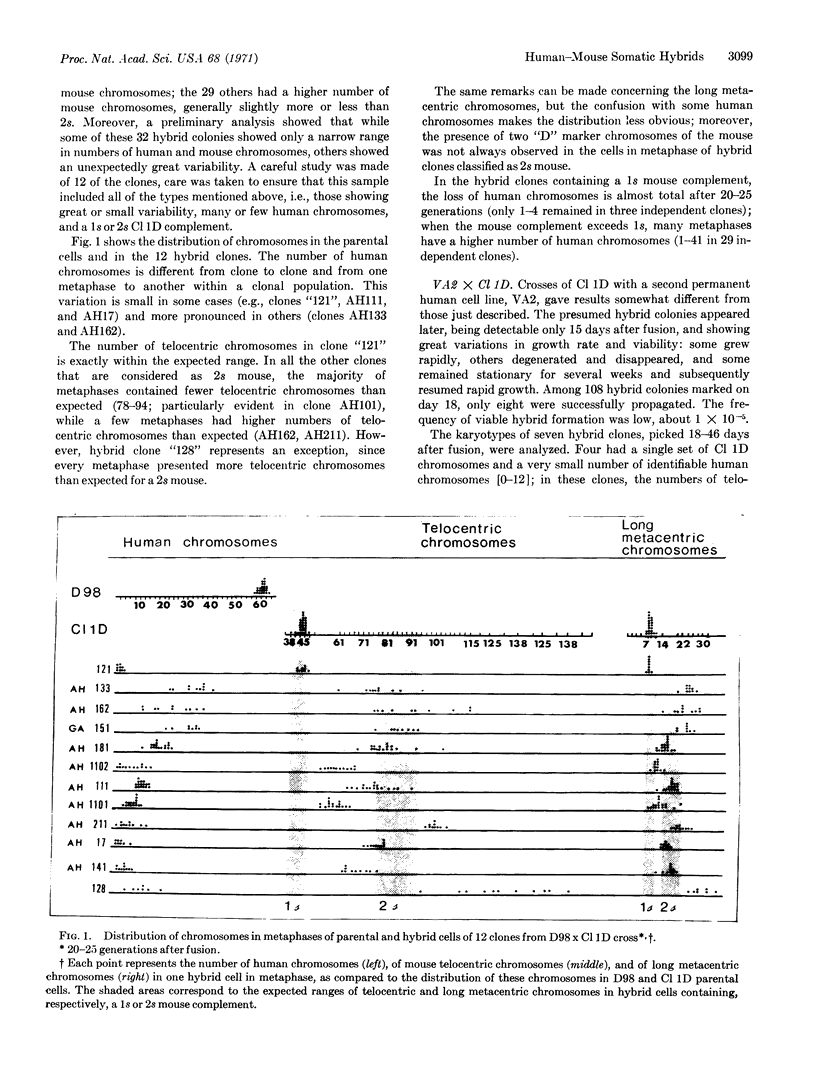
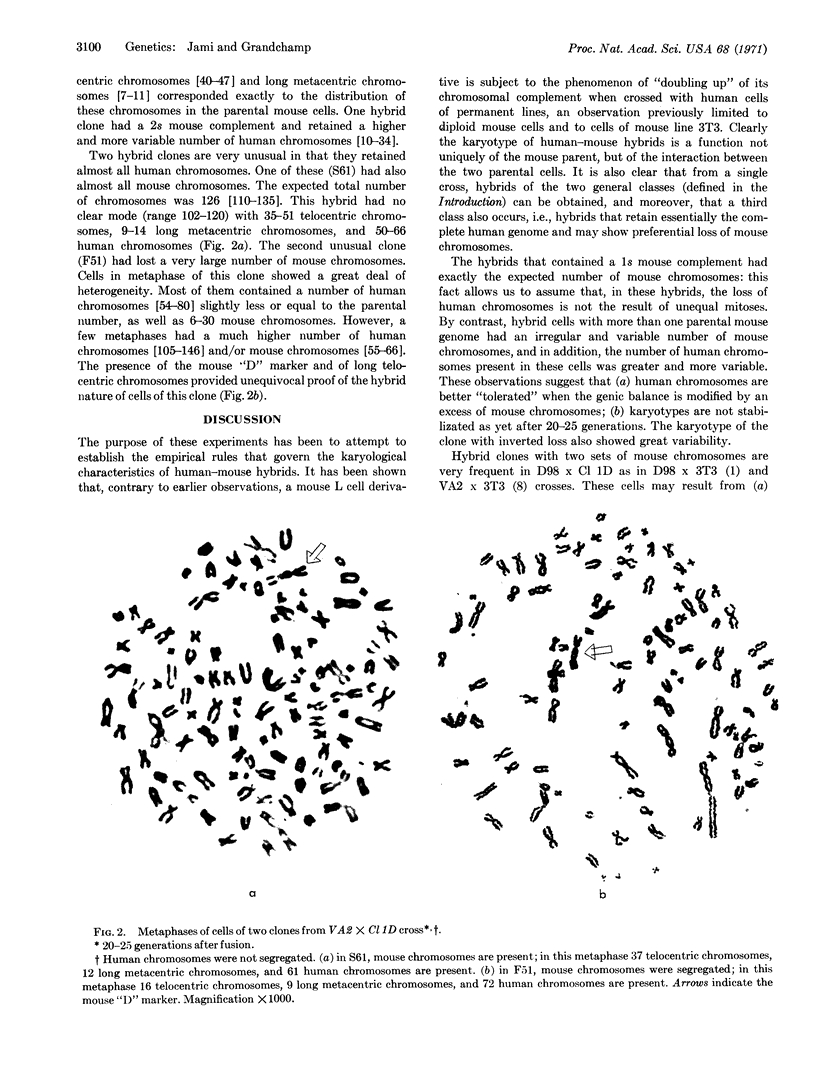
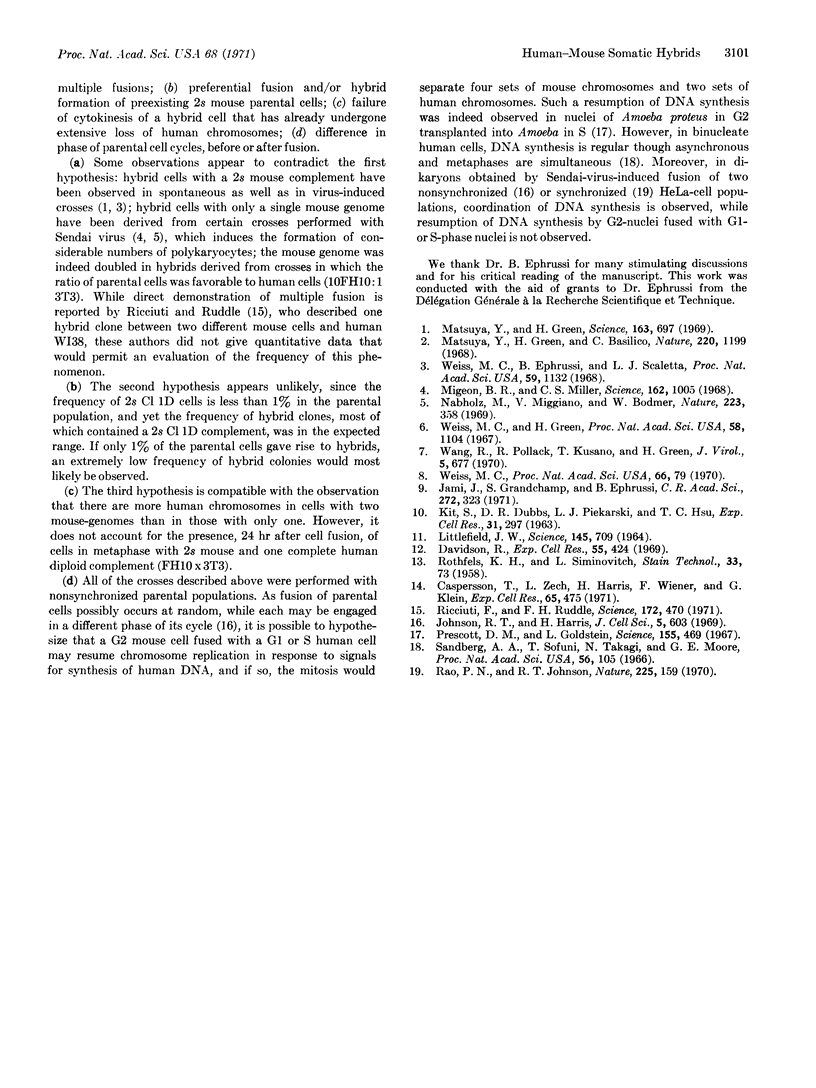
Images in this article
Selected References
These references are in PubMed. This may not be the complete list of references from this article.
- Caspersson T., Zech L., Harris H., Wiener F., Klein G. Identification of human chromosomes in a mouse-human hybrid by fluorescence techniques. Exp Cell Res. 1971 Apr;65(2):475–478. doi: 10.1016/0014-4827(71)90032-2. [DOI] [PubMed] [Google Scholar]
- Davidson R. Regulation of melanin synthesis in mammalian cells, as studied by somatic hybridization. 3. A method of increasing the frequency of cell fusion. Exp Cell Res. 1969 Jun;55(3):424–426. doi: 10.1016/0014-4827(69)90580-1. [DOI] [PubMed] [Google Scholar]
- Jami J., Grandchamp S., Ephrussi B. Sur le comportement caryologique des hybrides callulaires homme x souris. C R Acad Sci Hebd Seances Acad Sci D. 1971 Jan 11;272(2):323–326. [PubMed] [Google Scholar]
- Johnson R. T., Harris H. DNA synthesis and mitosis in fused cells. I. HeLa homokaryons. J Cell Sci. 1969 Nov;5(3):603–624. doi: 10.1242/jcs.5.3.603. [DOI] [PubMed] [Google Scholar]
- KIT S., DUBBS D. R., PIEKARSKI L. J., HSU T. C. DELETION OF THYMIDINE KINASE ACTIVITY FROM L CELLS RESISTANT TO BROMODEOXYURIDINE. Exp Cell Res. 1963 Aug;31:297–312. doi: 10.1016/0014-4827(63)90007-7. [DOI] [PubMed] [Google Scholar]
- LITTLEFIELD J. W. SELECTION OF HYBRIDS FROM MATINGS OF FIBROBLASTS IN VITRO AND THEIR PRESUMED RECOMBINANTS. Science. 1964 Aug 14;145(3633):709–710. doi: 10.1126/science.145.3633.709. [DOI] [PubMed] [Google Scholar]
- Matsuya Y., Green H., Basilico C. Properties and uses of human-mouse hybrid cell lines. Nature. 1968 Dec 21;220(5173):1199–1202. doi: 10.1038/2201199a0. [DOI] [PubMed] [Google Scholar]
- Matsuya Y., Green H. Somatic cell hybrid between the established human line D98 (presumptive HeLa) and 3T3. Science. 1969 Feb 14;163(3868):697–698. doi: 10.1126/science.163.3868.697. [DOI] [PubMed] [Google Scholar]
- Migeon B. R., Miller C. S. Human-mouse somatic cell hybrids with single human chromosome (group E): link with thymidine kinase activity. Science. 1968 Nov 29;162(3857):1005–1006. doi: 10.1126/science.162.3857.1005. [DOI] [PubMed] [Google Scholar]
- Nabholz M., Miggiano V., Bodmer W. Genetic analysis with human--mouse somatic cell hybrids. Nature. 1969 Jul 26;223(5204):358–363. doi: 10.1038/223358a0. [DOI] [PubMed] [Google Scholar]
- Prescott D. M., Goldstein L. Nuclear-cytoplasmic interaction in DNA synthesis. Science. 1967 Jan 27;155(3761):469–470. doi: 10.1126/science.155.3761.469. [DOI] [PubMed] [Google Scholar]
- ROTHFELS K. H., SIMINOVITCH L. An air-drying technique for flattening chromosomes in mammalian oells grown in vitro. Stain Technol. 1958 Mar;33(2):73–77. doi: 10.3109/10520295809111827. [DOI] [PubMed] [Google Scholar]
- Rao P. N., Johnson R. T. Mammalian cell fusion: studies on the regulation of DNA synthesis and mitosis. Nature. 1970 Jan 10;225(5228):159–164. doi: 10.1038/225159a0. [DOI] [PubMed] [Google Scholar]
- Ricciuti F., Ruddle F. H. Biochemical and cytological evidence for triple hybrid cell line formed from fusion of three different cells. Science. 1971 Apr 30;172(3982):470–472. doi: 10.1126/science.172.3982.470. [DOI] [PubMed] [Google Scholar]
- Sandberg A. A., Sofuni T., Takagi N., Moore G. E. Chronology and pattern of human chromosome replication, IV. Autoradiographic studies of binucleate cells. Proc Natl Acad Sci U S A. 1966 Jul;56(1):105–110. doi: 10.1073/pnas.56.1.105. [DOI] [PMC free article] [PubMed] [Google Scholar]
- Wang R., Pollack R., Kusano T., Green H. Human-mouse hybrid cell lines and susceptibility to poliovirus. I. Conversion from polio sensitivity to polio resistance accompanying loss of human gene-dependent polio receptors. J Virol. 1970 Jun;5(6):677–681. doi: 10.1128/jvi.5.6.677-681.1970. [DOI] [PMC free article] [PubMed] [Google Scholar]
- Weiss M. C., Ephrussi B., Scaletta L. J. Loss of T-antigen from somatic hybrids between mouse cells and SV40-transformed human cells. Proc Natl Acad Sci U S A. 1968 Apr;59(4):1132–1135. doi: 10.1073/pnas.59.4.1132. [DOI] [PMC free article] [PubMed] [Google Scholar]
- Weiss M. C. Further studies on loss of T-antigen from somatic hybrids between mouse cells and SV40-transformed human cells. Proc Natl Acad Sci U S A. 1970 May;66(1):79–86. doi: 10.1073/pnas.66.1.79. [DOI] [PMC free article] [PubMed] [Google Scholar]
- Weiss M. C., Green H. Human-mouse hybrid cell lines containing partial complements of human chromosomes and functioning human genes. Proc Natl Acad Sci U S A. 1967 Sep;58(3):1104–1111. doi: 10.1073/pnas.58.3.1104. [DOI] [PMC free article] [PubMed] [Google Scholar]




